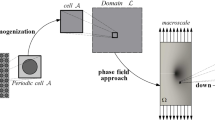Abstract
The presence of multiple microcracks in a structural component causes material degradation such as reduction in the stiffness or reduction in the fracture toughness of the component. In this paper, the homogenization method is used to evaluate mechanical properties of the damaged material. The adaptation of the superposition method to the homogenization method is also presented. The proposed method makes use of the finite element solution of uncracked solid and the analytical solution. The effective elastic moduli of damaged materials containing lattice-distribution microcracks are estimated by the proposed method. Furthermore, the stress fields and the stress intensity factors of the elliptical microcracks in the damaged material at a micro-mechanics scale are evaluated to illustrate microscopic behavior such as crack interaction.
Similar content being viewed by others
References
Budiansky, B. and 0' Connell, R.J. (1976). Elastic moduli of a cracked solid. International Journal of Solids and Structures 12, 81–97.
Chow, C.L. and Wang, J. (1987). An anisotropic theory of continuum damage mechanics for ductile fracture. Engineering Fracture Mechanics 27, 547–558.
Delameter, W.R., Ferrmann, G. and Barnett, D.M. (1975). Weakening of an elastic solid by a rectangular array of cracks. Journal of applied Mechanics 74, 74–80.
Fares, N. (1992). Effective stiffness of cracked elastic solids. Applied Mechanics Review 45, 336–345.
Fares, N. (1993). Effective stiffness of a periodically cracked 3-D solid. International Journal of Fracture 62, 149–162.
Guedes, J.M. and Kikuchi, N. (1990). Preprocessing and postprocessing for materials based on the homogenization method with Adaptive Finite Methods. Computer Methods in applied Mechanics and Engineering 83, 143–198.
Hollister, S.J. and Kikuchi, N. (1992). A comparison of homogenization and standard mechanics analyses for periodic porous composites. Computational Mechanics 10, 73–95.
Nemat-Nasser, S. and Hori, M. (1974). Micromechanics: Overall Properties of Heterogeneous Materials, North-Holland, Amsterdam.
Nemat-Nasser, S., Yu, N. and Hori, M. (1993). Solids with periodically distributed cracks. International Journal of Solids and Structures 30, 2071–2095.
Nishioka, T. and Atluri, S.N. (1983). Analytical solution for embedded elliptical cracks, and finite element alternating method for elliptical surface cracks, subjected to arbitrary loadings. Engineering Fracture Mechanics 17, 247–268.
Nishioka, T. and Kato, T. (1998a). An alternating method based on the VNA solution for analysis of damaged solid containing arbitrarily distributed elliptical microcracks. International Journal of Fracture 89, 159–192.
Nishioka, T. and Kato, T. (1998b). An evaluation method for microscopic and macroscopic properties of damaged materials containing distributed elliptical microcracks. Journal of the Society of Materials Science Japan 47, 1258–1263.
Sanchez-Palencia, E. (1980). Non-homogeneous media and vibration theory. Lecture Notes in Physics 127, Springer-Verlag, Berlin.
Shah, R.C. and Kobayashi, A.S. (1974). Elliptical crack in a finite-thickness plate subjected to tensile and bending loading. Journal of Pressure Vessel Technology 96, 47–54.
Suquet, P. (1987). Elements of homogenization theory for inelastic solid mechanics. In: Homogenization Techniques for Composite Media (edited by Sanchez-Palencia, E. and Zaoui, A.) Springer-Verlag, Berlin, 194–278.
Vijayakumar, K. and Atluri, S.N. (1981). An embedded elliptical flaw in an infinite solid, subject to arbitrary crack-face tractions. Journal of Applied Mechanics 48, 88–96.
Yagawa, G., Nishioka, T., Ando, Y. and Ogura, N. (1975a). The finite element calculation of stress intensity factors using superposition. Computational Fracture Mechanics (edited by Rybicki, E.F. and Benzley, S.E.), 21–34.
Yagawa, G., Nishioka, T. and Ando, Y. (1975b). Elastic-plastic finite element analysis using superposition. Nuclear Engineering and Design 34, 247–254.
Author information
Authors and Affiliations
Rights and permissions
About this article
Cite this article
Kato, T., Nishioka, T. Analysis of damaged material containing periodically distributed elliptical microcracks by using the homogenization method based on the superposition method. International Journal of Fracture 115, 305–321 (2002). https://doi.org/10.1023/A:1016361722528
Issue Date:
DOI: https://doi.org/10.1023/A:1016361722528




